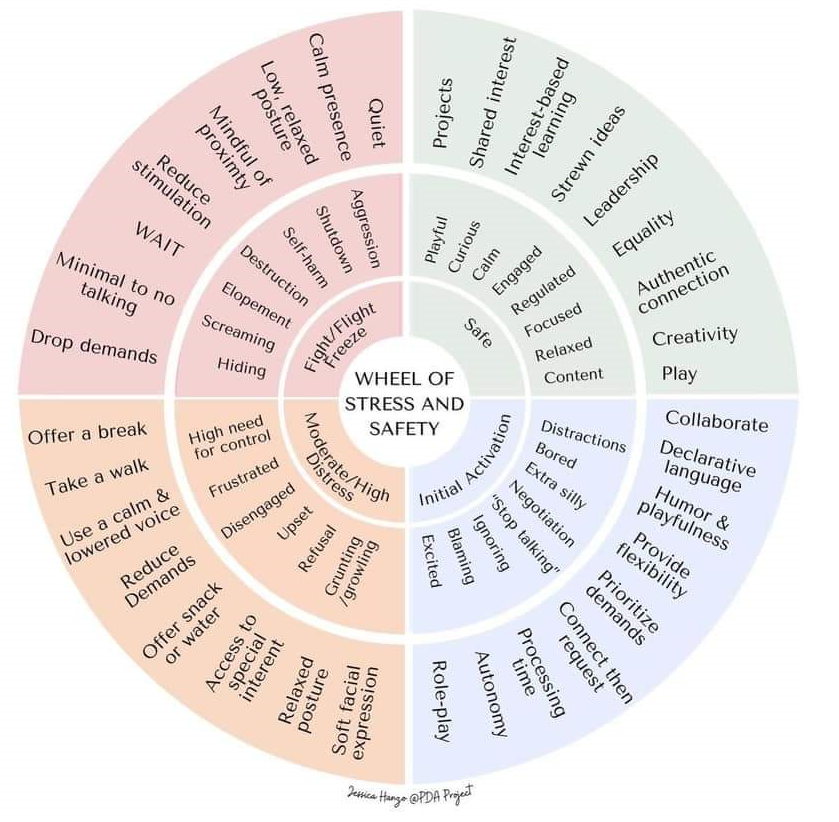Listen to the audio version here
I was on the phone with an old student of mine. I asked her how’s it been going at university? She said, well I have an assignment for tomorrow and I didn’t get started yet. We both laughed, because how often have I heard that from her, she will never change!
You know how they say when you have a near death experience, life flashes backwards in front of your eyes? That’s exactly what happened … suddenly all the things she had said and done over her school years flashed in front of my eyes … waiting last second to do her work, working till 1am in the morning, working best at night pulling all nighters, not being able to focus for learning at home, but perfectly able to focus when I was next to her – the body double effect, not being able to get started, blocking when writing but being able to write if just given a prompt, depressive periods, anxiety, emotions, and all those other apparently small things … suddenly everything made sense.
Ohhh shhhooot. She has it! I had been teaching her for years and years, I had seen her struggles, I had helped her through the depression and I saw nothing! Nothing!
I told her, please, if you trust me with anything, get yourself tested for ADHD.
She told me nah, I don’t have ADHD .. yea, that’s what I thought when I got diagnosed with it. And that’s what so many of us think and what so many of the people we know think when they hear you have ADHD .. nah, you don’t have ADHD, you’re alright!
But she trusted me and did the test and surprise … she has it.
I had been teaching and training teachers for a long time by now and am somebody who cares about her students a lot and I thought I knew! Ha! I thought I knew!
I knew nothing! Nothing! How was that possible?
You have no idea what you are dealing with
I went back to notes from professional training sessions we got on learning disorders .. there it was. ADHD … hyperactivity – bounces of the walls, lack of focus – daydreaming and impulsiveness – blurt out answers or interrupting others …
That was about it. That’s where it ended. Next: dyslexia!
Something I can tell you, when you ask parents of kids with ADHD or those who actually have ADHD, they will tell you .. the hyperactivity is not even the problem. The no focus, is not even the problem and the impulsiveness is not even the problem.
Everything that comes along with it and nobody knows about – is the problem.
Or let me rephrase that. Those 3 points do cause problems, and big ones at times, but they are not the only ones, there are worse and there are more and all of them combined are the issue.
You thought you knew what ADHD is, but you have no clue! And you will never have a clue if you do not talk to somebody who actually has it and knows that they have it and are educated about it!
I got into hyperfocus … how was it possible that I didn’t know? Not for my students and not even for myself? How did I not know? …the more I spoke to people … everyone I could literally get my hands on who has ADHD, works with people with ADHD, neuroscientists, psychiatrists, therapists, teachers … I would annoy the heck out of them to ask my questions and get feedback on thoughts.
I felt so bad about myself for having let her down. In my head I thought, how is it possible that you set a foot into a classroom and you did not know all this? How many children did I fail? I have seen them getting sent to psychologists who in turn diagnosed them with everything and anything, except for what was really going on.
I hate injustice and I hate it when people let other people down, especially those who have responsibility and that person is at your mercy.
So I asked every single teacher that crossed my way – and I mean literally just crossed my way “in a café, waitress second job, first job teacher … come, sit with me for a second, can I ask you a few questions? – and asked them hey, what do you know about ADHD?
There are the answers I got:
– AD what? – You know, TDAH in French? – Ha? – That hyper…nevermind!
– you mean those kids that can’t learn?
– you mean those hyperactive ones? Yea you know, I have a child with autism in the class this year, too.
That’s … nice … just that I was talking about ADHD, not autism, it’s not the same thing, you know? And what do you mean you have ONE child, THIS year, too? I have at least 4 … EVERY year in EACH class!
– you mean those kids that can’t focus? Oh yea, I know everything! Our school has them well looked after, with individual plans that are sent to us by their psychiatrists.
Ah right … the individual plans … make me cry … those copy paste pdf files that they send out to everyone, and sometimes even forget to change the name of the child on the top … this is how much they care to make it individualized!
They may make sense to you, like … don’t let them sit next to a window or break big tasks into smaller ones …
First of, I know kids .. the window saved their lives during school time. And I rarely met a teacher who actually knew how to exactly break down the big tasks into smaller ones. Sounds like self-explanatory, doesn’t it. But it isn’t! I know a parent that had to explain to her kid’s math teacher how to break down tasks so that her daughter could follow what he was talking about.
Because we get no training on such details. Here is a list of what to do, but how exactly that looks like … good luck!
And that’s exactly what was going on … and it did not matter how old or experienced the teachers were that I asked. Just that the younger generation seemed to care a little more about the whole thing and were more curious and empathic with those kids and wanted to know more. Whereas the older ones were more like “I know what I’m doing, go away”.
The iceberg – a high stakes game
Among ADHDers there is a famous picture of an iceberg. On the top you see the previously named 3 things (hyperactivity, focus, impulse) and under the water you see … many many other things!
In this series, I would like to introduce you to what you see on the top of the iceberg and what they actually imply and then have a look at what’s going on underneath. And how this effects the kids or the adults in the classroom and their lives.
Should you leave it undiagnosed and the kids or adults don’t learn the right strategies, they can turn into real life issues – and not pretty ones.
We are looking at addictions, unemployment, financial issues, prison, relationship issues, early death – women more than men. And the later the diagnosis the higher the risk of early death. Children diagnosed under the age of 6 have around double the risk of early death. This risk turns into 4 times the risk by the age of 18 and undiagnosed.
Cause of deaths: accidents, substance abuse, any other risky behaviours such as eating disorders … among other things. Not the ADHD itself!!
If they get diagnosed and/or learn the right strategies, they can be handled and even made into an advantage that surpasses everyone else. It’s a high stakes game!
ADHD is a spectrum
But before we have a look at that iceberg, I need to remind you of something.
ADHD is a spectrum and it will never go away! No medication, no therapy no nothing will make it go away! It is not curable! But you can get a person with ADHD from one side of the spectrum to the other. But they will keep to be the person they are!
That means you can have a person that looks totally fine, can do all the things needed – just they do things differently. They came up with strategies that worked for them and can function well with them in place.
Then you have the other end where the person with ADHD is completely not functional.
How that looks like, we will talk about it. Let me give you an example to make it more visible to you.
I will use our neurodivergent autistic fellows for this. Autism, like ADHD is a spectrum as well, but I feel it’s a lot more visible to everyones eyes if it’s a severe case, whereas ADHD can mask itself very well and only show it’s severity to the person concerned and immediate people around them.
I used to volunteer in a center for autistic children. The parents would bring their child into the center and then psychologists and volunteers would take turns in taking care of those children. It was a humbling experience, because the children I saw were the ones you would say … on the other end of the spectrum.
I was in charge of 2 children. One boy aged 13 and one girl aged 8.
The boy reminded me of the movie the green mile. John Coffey, the big black man, who got convicted and killed for something he hadn’t done.
This boy looked exactly like him. He was young, but he was very big, surpassed me by miles. Let’s call him John then. John did not speak, he would enjoy ball baths … you know, those ball baths that usually toddlers love so much? He couldn’t look at you, often you wondered if he could even hear you. He would moan or shout, out of nothing – so it seems. Often he would bang his head against the wall with such a force for what we believed no reason. But it turned out that John had an extraordinary hearing. And got so disturbed by the noise of passing cars that it hurt his head. So he banged it against the wall because he didn’t know how to tell us. Head canceling headphones helped, sign language …
With his size and his violent behaviour against (only!) himself, he sometimes made me scared, but he was the sweetest of souls.
Amandine was 8. In her room she had a swing. If she could .. she would swing all day. And no, I’m not saying that as a means of exaggeration. I could leave her on the swing for 2 hours, but that’s not the goal. The goal was to come up with games and stimulate her.
Like John, she did not speak, she did not listen, she did not look into your eyes. But she would sit on the swing and sing, own songs she made up in her head … no real words, sometimes just letters or sounds. She was in her own world, not even trying to get out.
The goal, my mentor who was a psychologist said, is to get her out of her bubble by engaging her with activities and talking to her. She never wanted to do anything else than the swing.
One day, she was on her swing, singing … I stood in front of her, trying to convince her to come down and play something with me. In that moment our eyes met. She stared in my eyes and I stared into hers .. until my eyes became teary. They looked empty. At the same time I had the impression that she was trying to communicate with me through her eyes ….
What is going on in your head, Amandine? Why don’t you come out into this world? Why do you prefer to stay in there? I’m here for you! We are all here for you! Why do you stay alone? Please come out, play with me.
I tried to take her hand and have her come down the swing and play with me. But she started screaming and jumped back on the swing.
I was not able to continue volunteering. I would have loved to. But I was not mature enough. I could not handle what I saw. I didn’t have the knowledge that was needed, I didn’t have the distance that was needed, I had too much empathy, I could only imagine what it must feel like to be there. It caused too much pain.
It is NOT what you think it is
So in my head … this was what autism looked like … just like you probably think ADHD are the kids that make you crazy by acting out openly, climbing trees too high, annoying everyone, making all a mess in a classroom and around them, those who daydream all day, those who cut you in the middle of the sentence nonstop, those who get nothing straight … the one side of the spectrum.
Then what happened was that I met a woman in a café, we had a wonderful conversation. “She seemed totally normal to me.”
And then she told me she is on the spectrum. What spectrum? Autism. How? What do you mean how?
The common answer I get, when I say that I have ADHD:
What do you mean you have ADHD? You are the last person I would have thought has it. Yep, including me … because I never knew the other side of the spectrum.
I will show you symptoms of ADHD in this series. But you have to understand .. all those symptoms will show up in different degrees with people!
So that means, just because you know a person with ADHD, doesn’t mean you have any idea about what ADHD really is. To get a good picture, you have to hear the experiences of as many people with ADHD as possible.
I know somebody with ADHD here where I live and while we have many things in common, way more things not. Just because you have ADHD doesn’t mean we will be best friends. BUT, I WILL understand you!
We may deal with things a completely different way. So at times we can come across as opposites to the outside world. We may both hate injustice, but how we see it and deal with it are opposite. We may both block on assignments but how we deal with it is opposite, we may both be impulsive but how exaclty that shows may be very different …
So for example, I will tell you about executive functioning, don’t worry about it, if you don’t know what it is, we will talk about it.
But let’s say some people with ADHD have a problem managing their time 80%, others 40%. Some may struggle completeing tasks 90%, others 30%, . Some have a problem regulating their emotions 97%, others 32%… you see any degree is possible.
As a teacher or any adult really, it is not your job to diagnose those kids. But it IS your job to see that something may be off and then send them to the right place where they get the support that they need. And more often than not this “something off”, is not as much in your face as you would believe!

“Inside an ADHD mind”…

… because that’s simply the essence of what this blog is about.
Hello there,
I have been a teacher and teacher trainer for quite a few years now and I thought I knew what ADHD is … Or neurodiversity in general. But wow was I wrong!
I recently got diagnosed with ADHD – Attention Deficit and Hyperactivity Disorder as they call it – a revelation that came later in life, as it does for so many of us.
This is such an interesting time for me as I see the effects of ADHD in every area of my own life and also in the life of my students and trainees.
A time full of thoughts and emotions and encouragment to share it with those who might find solace in my words.
While I may not be a psychiatrist, I have lived every day of my life with undiagnosed ADHD, very well acquainted with its twists and turns but also with it’s wonderful sides which often are not talked about a lot. Witnessing countless children pass through my classrooms, each struggling under the weight of misunderstanding and mistreatment for a condition they never asked for, only strengthens my resolve to provide a look into an ADHD mind and how our brain may work.
So whenever you read something on here, imagine that this is your ADHD child / student speaking to you. or maybe your ADHD adult that used to be that child and now has to live with the consequences.
And yes, I know you deserve a perfect blog post to read but you will find spelling mistakes, grammar mistakes, form mistakes, maybe jumps in thoughts. This is me.
So here is my invitation to you – a glimpse into my mind, my perspective, my journey, and my truth. Welcome to my world!






Leave a comment